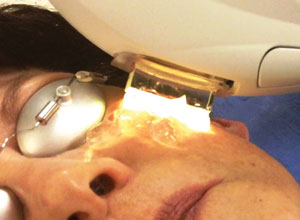  |
Surgical eye care is not often undertaken by choice. LASIK is the marquee item in elective eye surgery, and cataract patients can incorporate refractive correction into the surgical protocol. Most others would consider surgery only as a last resort. But now, some dry eye patients can choose to augment their traditional management approach of lid hygiene and topical therapy with a procedure that isn’t quite surgery, done with a device that isn’t quite a laser.
Intense pulsed light (IPL) therapy is used in dermatology to treat skin conditions such as rosacea and as a cosmetic enhancement for the removal of hair, vascular lesions and pigmented lesions. IPL is also popular for creating smoother, blemish-free skin.
Recently, we have heard many doctors performing IPL report that patients claim to have improved dry eye symptoms after treatments. IPL has been described as a potentially beneficial treatment for ocular rosacea and dry eye related to meibomian gland dysfunction (MGD). A recently published study showed an increase in lipid layer grade and noninvasive tear break-up time, in addition to a decrease in patient symptoms compared to placebo.1
How it Works
IPL is a non-laser, broad wavelength, high intensity flash of light that is applied using a handpiece that contacts the skin through a sapphire or quartz block. The intensity, duration and wavelengths can all vary based on the patient’s skin type and treatment goals.
The specific mechanism of action is not well understood, but is believed to be partially due to the thermal heating of the meibum coupled with the therapeutic effects of treating superficial telangiectasia. Energy is absorbed by skin chromophores, leading to lysis, causing only minimal collateral damage to neighboring cells.
 | |
| A contact gel is used with IPL to increase transmission and decrease burn risk. |
The block heats up significantly during treatment, so many systems use a refrigerant to cool the block between pulses, lessening the risk of burn and improving comfort.
The only significant risk with IPL is the use of excessive amounts of energy, which can cause permanent skin depigmentation. While not a serious medical problem, it can be a permanent aesthetic concern.
IPL for MGD
Although there is no well-accepted method of treatment, most clinics will apply treatment to both cheek areas encroaching onto the lower eyelid, but not touching the eyelid margin. The treatment usually causes mild discomfort, and redness can persist for days before full resolution. Anywhere between three to seven treatments per year are usually recommended.
Many clinics are choosing to manually express the meibomian glands (MGs) immediately after IPL treatments to evacuate the glands and stimulate new meibum production. Because of IPL’s immediate heating effects, the glands are usually easier to express. After MG expression, patients may notice mild lid tenderness and swelling for several days, but it is rarely severe and always self-limiting.
Good candidates for IPL therapy have any combination of the following: dry eye symptoms related to MGD, eyelid or dermal telangiectasia, non-expressive MGs or poor tear lipid layer. It is important to counsel patients that this is not a cure, but an advanced management therapy. Although increased MG expression is often seen after a single treatment, multiple treatments are usually recommended over several months. However, long-term stability of MG improvement has not yet been established, and IPL may evolve into a Botox-like procedure that requires consistent reapplication to maintain effect.
Video courtesy of Josh Johnston, OD.

